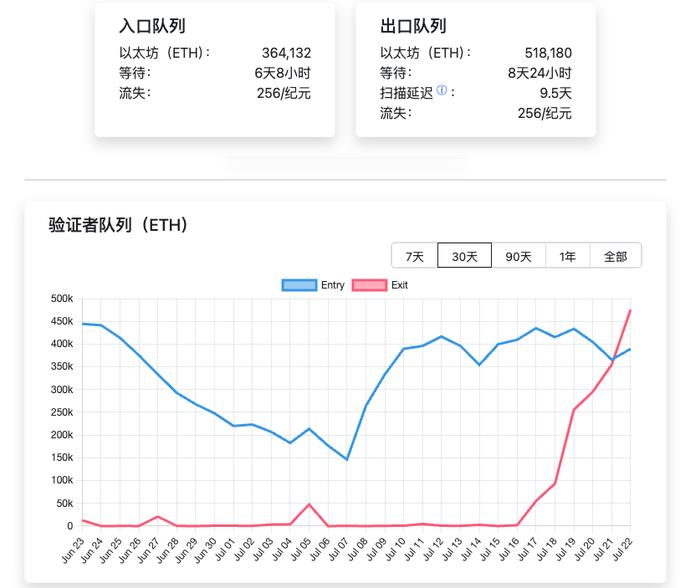Original Author: Prathik Desai
Original Translation: Saoirse, Foresight News
Three months ago, the prospect of an Ethereum ETF reaching its one-year anniversary seemed like a far-fetched dream, even for the most ardent Ethereum supporters, given the significant fund outflows, low market attention, and insufficient yield advantages.
However, the Ethereum ETF is now experiencing its moment of glory - having been in trading for a full year since its first launch on July 23, 2024.
In June 2025, the Ethereum ETF achieved its best monthly performance in history, with fund inflows exceeding $3.5 billion, 70% higher than the previous peak of $2.08 billion in December 2024. The momentum in July is even stronger, with inflows already surpassing $3 billion and potentially exceeding June's figure. The past two weeks until July 18 have been the best two weeks for net fund inflows, and it marks the first time in its 52-week existence that there have been ten consecutive weeks without any net outflows.
The "hockey stick" growth curve in the image below vividly illustrates this trend.
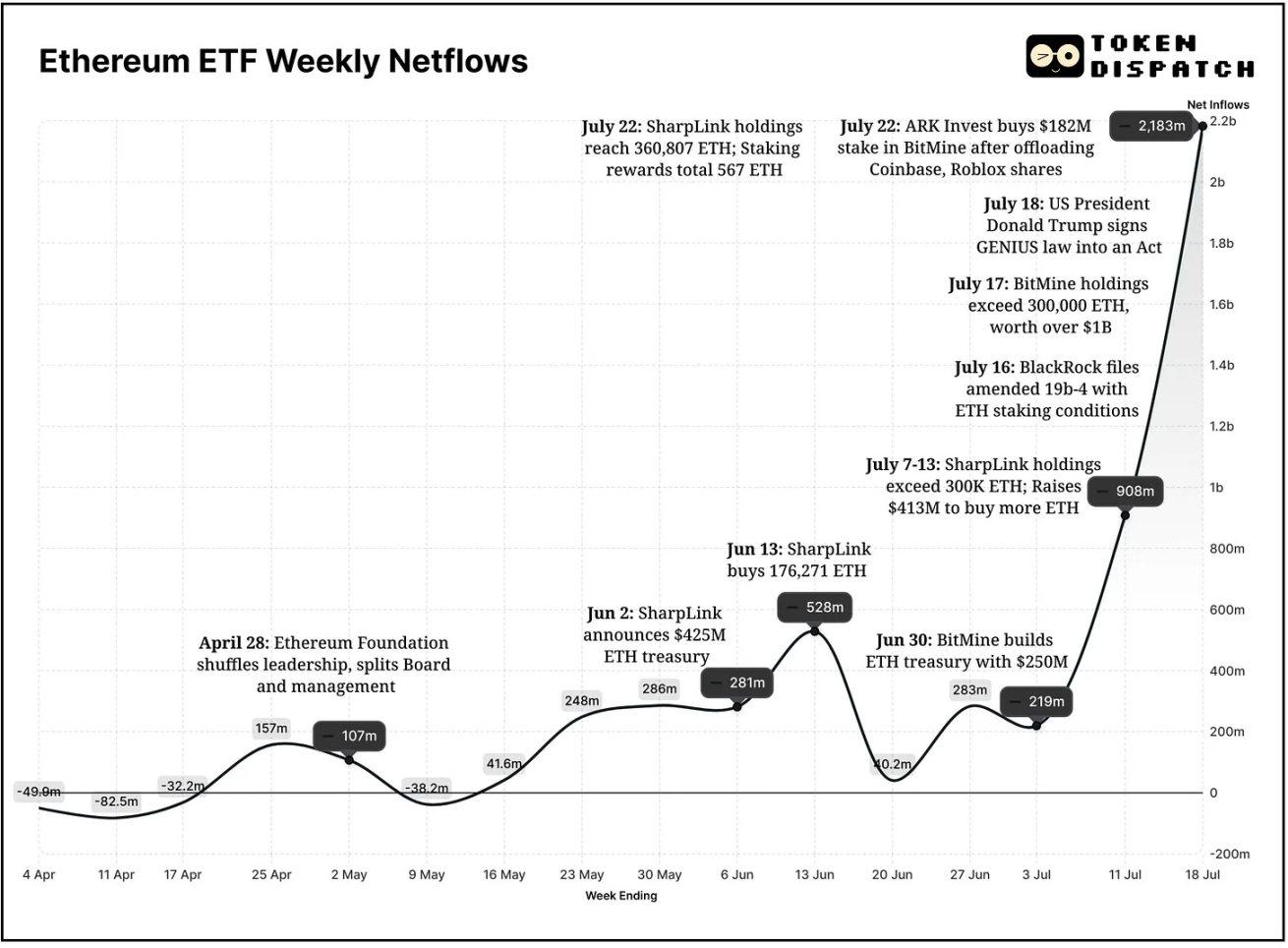
However, the development of the Ethereum ETF has not been smooth sailing.
In May 2024, U.S. regulators approved the Ethereum ETF, which officially began trading on July 23 of the same year, with mixed market reactions. After all, the Bitcoin ETF had already stolen the spotlight earlier in the year, and the Ethereum ETF's debut was relatively unremarkable: with sluggish price trends, declining attention, and no significant fund inflows during its initial period.
In fact, some initial fund movements even showed net outflows.
During the first 39 weeks of trading, the Ethereum ETF only saw net fund inflows in 15 weeks. In contrast, over the past 14 weeks, 13 weeks have shown net inflows, demonstrating the dramatic shift in direction over the past three months.
As of July 21, 2025, the Assets Under Management (AUM) of all U.S. Ethereum ETFs have exceeded $19 billion, doubling from approximately $9.6 billion two months ago.
Beyond ETFs, institutional interest in Ethereum is also accelerating through "Ethereum reserve assets".
On June 2, 2025, SharpLink Gaming became the first U.S. listed company to announce the inclusion of Ethereum in its strategic reserves. While the crypto world was still focused on companies adding Bitcoin to their balance sheets, Joe Lubin had already brought Ethereum to the "reserve asset party".
As the co-founder of Ethereum, founder and CEO of ConsenSys, Lubin joined SharpLink Gaming's board of directors as chairman and led the company's $425 million Ethereum strategic reserve.
Since the launch of this reserve asset plan, SharpLink has become the world's largest enterprise-level Ethereum holder, possessing 360,807 ETH, valued at over $1.3 billion at current prices. Additionally, the company has raised an extra $413 million and accumulated 567 ETH in staking rewards from its held Ethereum.
Moreover, in a supplementary prospectus submitted to the U.S. SEC, SharpLink requested an increase in its common stock saleable amount from the initially declared $1 billion to $5 billion.
However, a new company entering the Ethereum reserve asset space is fiercely competing with them.
Bitcoin mining company BitMine Immersion has also bet on Ethereum, holding over 300,000 ETH, valued at over $1 billion at current prices. Its chairman, Tom Lee, a Wall Street veteran, has even bigger ambitions:
"We are steadily advancing our goal, planning to acquire and stake 5% of Ethereum's total supply." Currently, the Ethereum holdings of SharpLink and BitMine already exceed those of the Ethereum Foundation.
Overall, the fund flows of Ethereum reserve asset companies and ETFs collectively reflect institutional confidence in Ethereum as an infrastructure layer, and this confidence continues to strengthen.
Cathie Wood's ARK Invest recently reduced its holdings in Coinbase and Roblox, instead increasing its investment in BitMine Immersion to $182 million. ARK, which previously had insufficient Ethereum exposure, restructured its three flagship ETFs, allocating 1.5% of its portfolio to BitMine.
Billionaire Peter Thiel also holds 9.1% of the company's shares.
The newly formed company Ether Machine, created through the merger of existing companies, will build a public trading platform providing institutional investors with professional channels to access Ethereum infrastructure and Ether yields.
The company was co-founded by Andrew Keys, former ConsenSys board member and director, and David Merin, former ConsenSys executive and current CEO of Ether Machine. After the merger, Ether Machine plans to be listed on NASDAQ, at which point it will hold over 400,000 ETH, valued at over $1.5 billion.
What changes have occurred in the past few months? The recent leadership changes at the Ethereum Foundation might be one reason.
In late April 2025, the Ethereum Foundation underwent leadership adjustments, separating the board and management. The new leadership clearly defined three core priorities: expanding Ethereum's base layer, optimizing Layer 2 Rollup solutions, and improving user experience.
Ethereum's practical value and earning potential have also made it an extremely attractive target for investors.
Currently, no U.S. ETF offers staking rewards, as the SEC has not yet approved this. If the Ethereum ETF ultimately introduces staking functionality, ETH could become a "digital bond" in institutional investment portfolios.
ETFs supporting staking could potentially provide 3-5% native yields. Based on the current $19.6 billion Ethereum holdings, even with an average yield of 4%, ETF issuers could generate over $750 million in staking income.
BlackRock is already exploring product structures that include staking, with its 19b-4 amendment file explicitly mentioning that staking is a "potential future function pending regulatory approval", and the market is watching closely.
Experts predict that the staking functionality for Ethereum ETFs may be approved in the fourth quarter of this year.
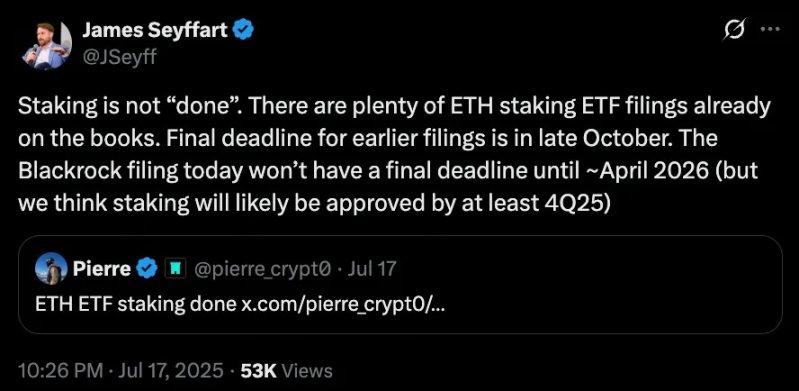
@JSeyff
For many investors, staking could be the key difference between "shallow allocation" and "deep participation". Passive income obtained through compliant investment tools may attract pension funds, endowment funds, and sovereign wealth funds.
Wintermute, a market maker and trading firm, noted in a report during the Ethereum ETF launch last year that the lack of a staking mechanism was a major weakness that could "diminish Ethereum's attractiveness as an ETF vehicle".
If the macroeconomic environment changes, such as interest rate cuts, stabilized inflation, or capital seeking higher returns, Ethereum would become a highly competitive choice: combining the scarcity of deflationary supply, the yield from staking, and accessibility through ETFs and custodial institutions.
Ethereum's price has already shown correlation with institutional activity. Further price breakthroughs might trigger market optimism and attract more capital inflows. Regardless, after a long period of dormancy, Ethereum's evolution will be welcomed by both retail and institutional investors.
Over the past two weeks, Ethereum's price has surged over 50%, reaching a new high in 2025; over the past three months, the cumulative increase has been 150%.
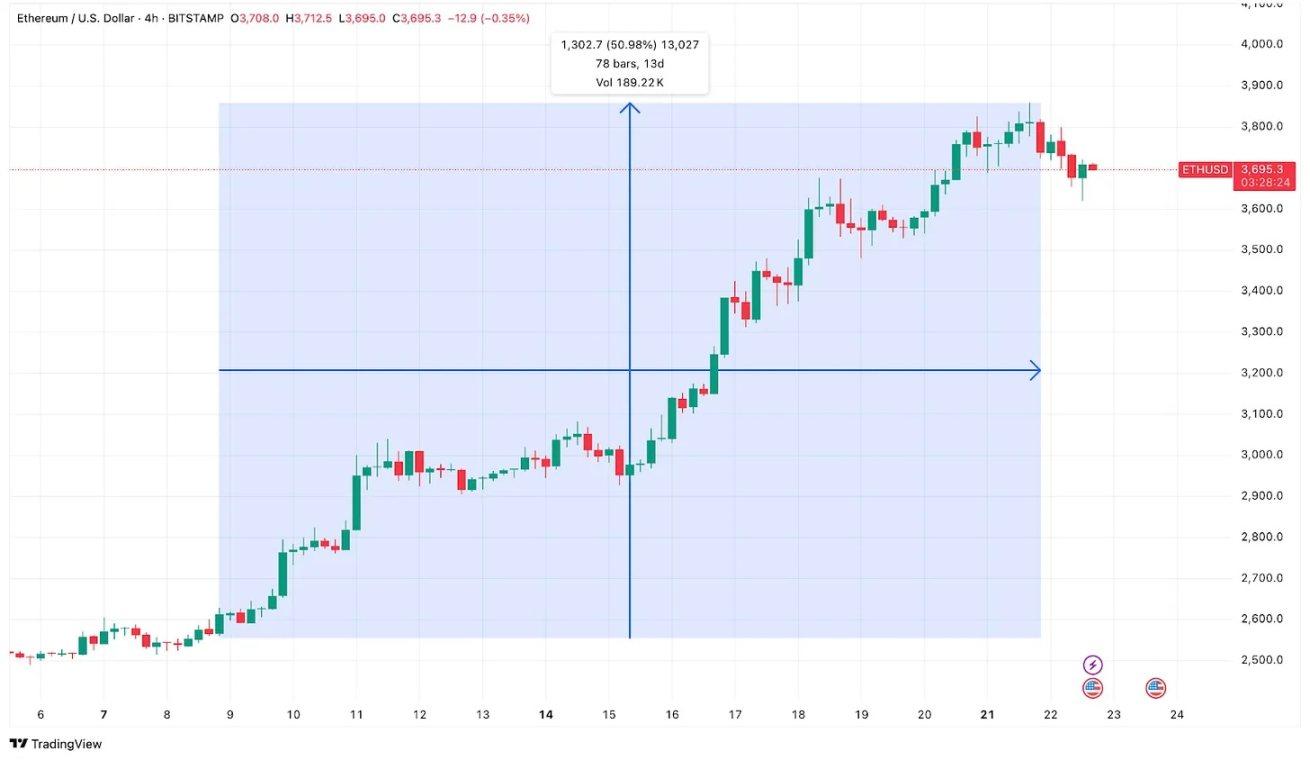
When ETFs issue new shares, they must buy ETH, which will lock in supply. The reduction in circulating ETH will create upward price pressure.
Ethereum reserve asset companies are also expected to hold ETH firmly. Registered investment advisors, wealth management institutions, and listed companies typically do not seek short-term gains and rarely engage in panic selling.
Reserve asset builders are positioning ETH as a programmable collateral, an asset that generates income, provides security, and maintains stability.
Moreover, the macro background is favorable: The "GENIUS Act" was recently signed into effect, legalizing stablecoins as digital cash. Ethereum, as the dominant network occupying 50% market share, will become the biggest beneficiary.
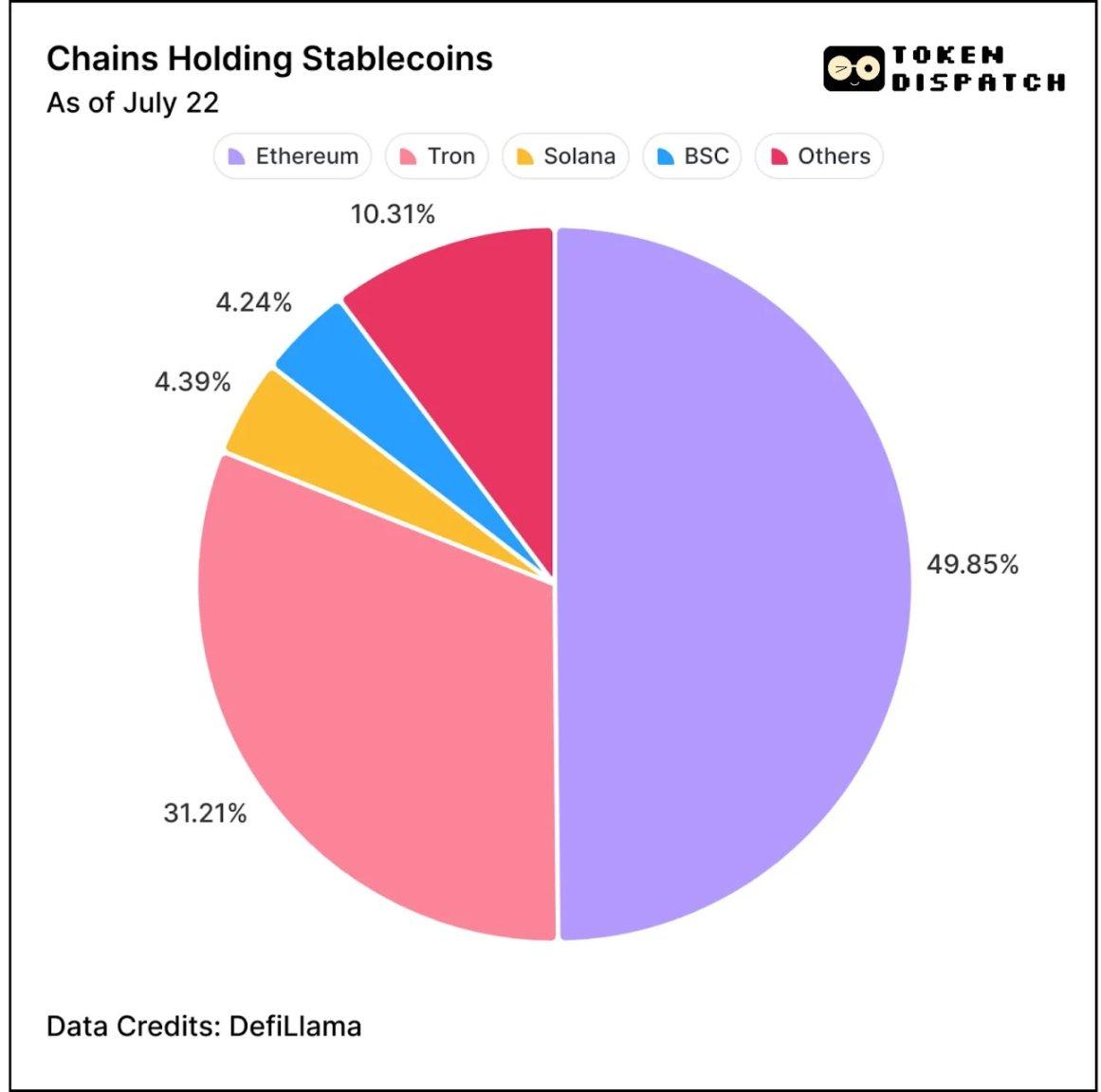
So, how will it develop in the future?
Once the SEC approves the ETF staking function, institutional interest is expected to continue warming up. More enterprises may establish Ethereum reserve assets due to the staking function, and asset management institutions like BlackRock will further increase their investment allocation in Ethereum.
For traditional investors, they may now realize that Ethereum already has two powerful circulation channels - ETF and reserve assets. Both lock in supply and expand Ethereum's influence into traditional economic fields.
Those who directly compare Bitcoin and Ethereum's reserve assets and ETFs actually overlook the core differences:
Bitcoin is viewed as a value storage tool, the "digital gold" in macro strategies; while Ethereum is endowed with practical uses. Fund issuers and reserve asset builders buy and support ETH, valuing its added value: staking rewards, infrastructure framework, and the programmable layer for financial applications.
Bitcoin is a "holding" asset, while Ethereum is an "application" network.




